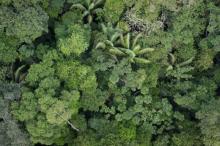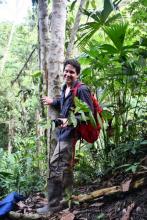Research Projects
 |
A. Habitat specialization and community assembly of Amazonian tree lineages Regional diversity is a product of the number of species found in a given location (alpha diversity) and the turnover in species composition across space and in different environments or habitats (beta diversity). In the lowland Amazon, there exists substantial turnover in species composition among terra firme, flooded and white-sand forests (Fine et al., 2010, Annals of the Missouri Botanical Garden). My dissertation work addressed the processes responsible for this compositional turnover in tree species on different soil types in the Western Amazon. I performed a phylogenetically-controlled reciprocal transplant experiment with 20 species from six tree genera in nutrient-poor white sand forests and nutrient-rich clay forests. I manipulated the presence of herbivores to see if the evolutionary tradeoff between defense investment and growth rate could explain the maintenance of habitat specialization. The results were clear and indicate that habitat specialization in these forests cannot be explained by soil factors alone. Clay specialist species outperformed white-sand specialists in both soil types when protected from herbivores. However, when unprotected, white-sand specialists dominated in white-sand forests and clay specialists dominated in clay forests. Herbivores, by preferentially attacking clay forest plants in white sand soils, thereby magnify habitat boundaries and increase the potential for habitat specialization in plants (Fine et al. 2004, Science). In addition, white-sand and clay specialist tree species exhibited a growth-defense tradeoff; functional traits associated with white-sand or clay specialization were not plastic responses to different soil types, but instead fixed traits shaped by natural selection that have evolved repeatedly by convergent evolution. This fundamental tradeoff, mediated by herbivores, represents an important mechanism of plant coexistence that has been largely overlooked in studies of plant habitat specialization and niche assembly (Fine et al. 2006, Ecology, Fine and Baraloto 2016, Biotropica). While evidence suggests that habitat specialization can be well explained by growth-defense tradeoffs, these insights remain to be integrated with large-scale distributional data and phylogenetic data in order to understand the general importance of habitat specialization at much larger taxonomic and geographic scales. Together with two collaborators, Chris Baraloto (INRA-France) and John Lokvam (Utah), I was awarded an NSF grant in Ecology (2008-2011) and Chris Baraloto was awarded a grant from ANR-France (2013-2018) to address the evolution of habitat specialization within five widespread Amazonian tree lineages in three countries spanning the entire Amazon basin. Together we have installed 116 0.1 ha plots in white sand, terra firme and flooded forest in Peru, Brazil and French Guiana to test for patterns of habitat specialization within each country. We have invested a great deal of time and energy to produce accurate, standardized species inventory data. All morphospecies from the 116 plots have been vouchered, and five important and species-rich lineages have been DNA-barcoded. All vouchers from the 80 plots in Peru and French Guiana were brought to the Missouri Botanical Garden (the largest Neotropical plant collection in the world), where we standardized the identification of lineages between Peru and French Guiana. In our 80 plots from just Peru and French Guiana, we have found more than 2300 tree morphospecies – and only a 6.5% overlap between countries. Initial results suggest that species from our focal tree lineages exhibit strong habitat associations (Lamarre et al. 2012, Ecology), but the most important papers summarizing our tree inventory results have yet to be published, although one is in in second revision (Baraloto et al., in review Ecological Monographs). We evaluated the contributions of abiotic and biotic mechanisms of performance tradeoffs by quantifying traits that confer flood tolerance, nutrient use efficiency, and chemical defense using a reciprocal transplant experiment that includes both habitat generalist and specialist tree species from each of our five focal lineages. Reciprocal transplant experiments with twenty species each in French Guiana and in Peru were conducted between 2009-2012. We found that habitat specialists outperformed non-specialists in each habitat, especially in seasonally-flooded and white-sand forests (Fortunel et al. 2016, Ecology Letters). We have measured soil characteristics and many physiological plant traits in the different habitat types and found evidence consistent with discrete and divergent plant strategies being favored in each habitat type (Fortunel, et al., 2012, Functional Ecology; Fortunel et al. 2014, Journal of Ecology, Fortunel et al. 2014, New Phytologist). We have also conducted multi-trophic inventories in the same plots where we have tree species abundance data, functional traits, and climate and soil variables. Students affiliated with our project developed innovative ways to sample insects in the tree plots using flight intercept traps (Lamarre et al. 2012, ZooKeys), light traps, fruit traps and tree sapling insect traps (Lopes et al. 2019, Entomologia Experimentalis et Applicata.). During his Ph.D. dissertation, working in Peru and French Guiana, Greg Lamarre collected more than 200,000 insects to compare diversity patterns between regions and across habitats. We found strong patterns of functional and phylogenetic betadiversity across habitats in insect communities (Lamarre et al. 2016, Journal of Animal Ecology, Lamarre et al. 2016, Biotropica). Similarly, in collaboration with Kabir Peay (Stanford), we surveyed fungal diversity in our Peruvian plots. We found that fungal and tree diversity were well-correlated, and that beta-diversity of fungal pathogens and tree beta-diversity were also correlated (Peay et al., 2013, The ISME Journal). These findings are consistent with what one would expect if fungal pathogens were responsible for causing density-dependent mortality in trees according to the Janzen-Connell hypothesis, one of the leading theories explaining the exceptional diversity of tropical forests. In part C (see below), I describe our efforts to further investigate density dependent mortality and its role in driving patterns of commonness and rarity in tropical trees. |
 |
B. The evolution of habitat specialization in Burseraceae trees |
| Habitat specialization and speciation mechanisms | |
| C. The role of interactions of plants and their enemies in the evolution of chemical defense |